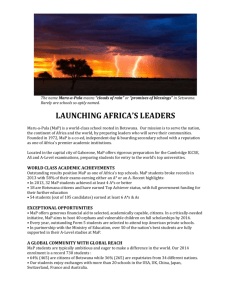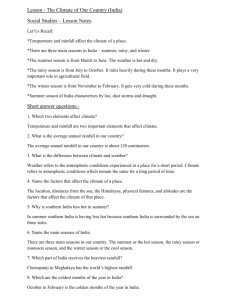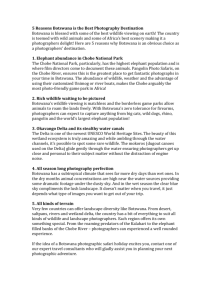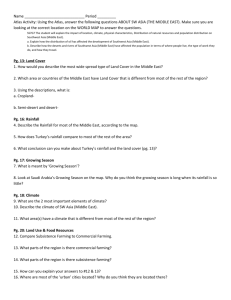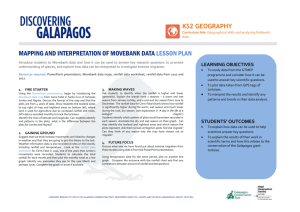Botswana Wildlife
advertisement
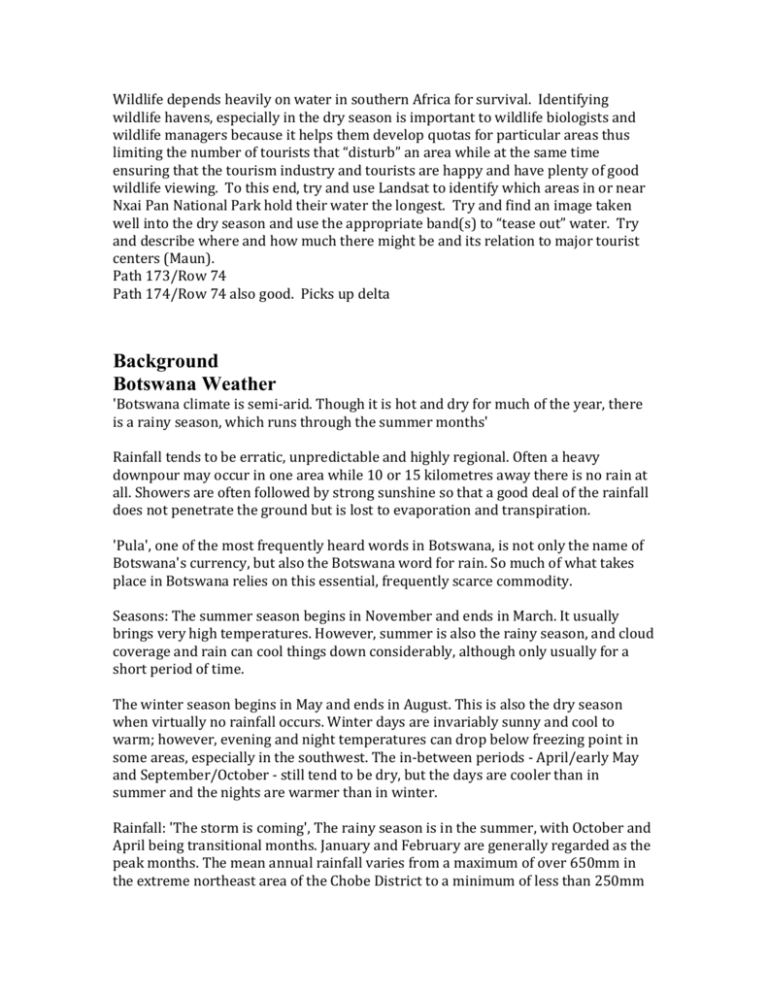
Wildlife depends heavily on water in southern Africa for survival. Identifying wildlife havens, especially in the dry season is important to wildlife biologists and wildlife managers because it helps them develop quotas for particular areas thus limiting the number of tourists that “disturb” an area while at the same time ensuring that the tourism industry and tourists are happy and have plenty of good wildlife viewing. To this end, try and use Landsat to identify which areas in or near Nxai Pan National Park hold their water the longest. Try and find an image taken well into the dry season and use the appropriate band(s) to “tease out” water. Try and describe where and how much there might be and its relation to major tourist centers (Maun). Path 173/Row 74 Path 174/Row 74 also good. Picks up delta Background Botswana Weather 'Botswana climate is semi-arid. Though it is hot and dry for much of the year, there is a rainy season, which runs through the summer months' Rainfall tends to be erratic, unpredictable and highly regional. Often a heavy downpour may occur in one area while 10 or 15 kilometres away there is no rain at all. Showers are often followed by strong sunshine so that a good deal of the rainfall does not penetrate the ground but is lost to evaporation and transpiration. 'Pula', one of the most frequently heard words in Botswana, is not only the name of Botswana's currency, but also the Botswana word for rain. So much of what takes place in Botswana relies on this essential, frequently scarce commodity. Seasons: The summer season begins in November and ends in March. It usually brings very high temperatures. However, summer is also the rainy season, and cloud coverage and rain can cool things down considerably, although only usually for a short period of time. The winter season begins in May and ends in August. This is also the dry season when virtually no rainfall occurs. Winter days are invariably sunny and cool to warm; however, evening and night temperatures can drop below freezing point in some areas, especially in the southwest. The in-between periods - April/early May and September/October - still tend to be dry, but the days are cooler than in summer and the nights are warmer than in winter. Rainfall: 'The storm is coming', The rainy season is in the summer, with October and April being transitional months. January and February are generally regarded as the peak months. The mean annual rainfall varies from a maximum of over 650mm in the extreme northeast area of the Chobe District to a minimum of less than 250mm in the extreme southwest part of Kgalagadi District (see the map for districts). Almost all rainfall occurs during the summer months while the winter period accounts for less than 10 percent of the annual rainfall. Generally, rainfall decreases in amount and increases in variability the further west and south you go. Temperatures: Summer days are hot, especially in the weeks that precede the coming of the cooling rains, and shade temperatures rise to the 38°C mark and higher, reaching a blistering 44°C on rare occasions. Winters are clear-skied and bone-dry, the air seductively warm during the daylight hours but, because there is no cloud cover, cold at night and in the early mornings. Sometimes bitterly so - frost is common and small quantities of water can freeze. Humidity: In summer during the morning period humidity ranges from 60 to 80% and drops to between 30 and 40% in the afternoon. In winter humidity is considerably less and can vary between 40 and 70% during the morning and fall to between 20 and 30% in the afternoon. For tourists, the best visiting months are from April through to October - in terms of both weather and game viewing. It is during this period that the wildlife of the great spaces gather around what water there is - the natural waterholes and the boreholefed dams - and are at their most visible. Just like the weather is often unpredictable - the below charts, provide you with a look at what the weather should be like on your stay in Africa. Please note that these are average figures only and weather is often unpredictable. Botswana Weather / Botswana Weather Charts Month Jan Feb Mar Apr May Maun 32/18 32/17 30/16 29/12 26/07 Maun 107 79 71 18 05 Maun 69 73 74 70 68 Jun 24/06 03 70 Average over 14 yrs Average Daily Max - Min ºC Rainfall (in mm) Relative Humidity (%) Botswana Weather / Botswana Weather Charts Month Jul Aug Sep Oct Nov Maun 24/06 27/09 33/14 35/15 33/19 Maun 00 00 00 23 56 Maun 63 60 55 56 63 Dec 33/19 86 65 Average over 14 yrs Average Daily Max - Min ºC Rainfall (in mm) Relative Humidity (%) Makgadikgadi & Nxai Pan National Park: Established at the same time, these two areas about 100km (60mi) east of Maun effectively operate as one national park. The southern area, Makgadikgadi Game Reserve, is a 4000 sq km (1600 sq mi) tract of pans, grasslands and beautiful savanna. Wildlife is plentiful, though not as dense as at Chobe. There are antelope, lion, hyena, cheetah, and hippo, as well as a stunning array of birds, but no elephant or buffalo. There's a campsite at the park with a toilet, cold shower and drinking water. You'll either need to join a tour or rent a 4WD to get there. The northern part of the park, Nxai Pan, takes in another 4000 sq km (1600 sq mi). The southern part of Nxai Pan is a complex of mini salt pans. This is one of the few areas in Botswana that's more interesting during the rainy season - when huge herds hit Nxai's grassy pans. The numbers can be staggering; wildebeest, zebra and gemsbok appear in their thousands, along with large herds of other antelope and giraffe. Lion, hyena and wild dog come to take advantage of the expanded menu, and this is also one of the few places you'll see bat-eared fox. In the south of Nxai Pan, Baines' Baobabs comprise a hardy clump of large baobab trees, rendered immortal in 1862 by painter Thomas Baines, a member of Livingstone's expedition. If you've seen a copy of the painting, you'll notice that only one branch has fallen off in the last 100 years. There are no facilities at Nxai Pan's campsites, and you'll need a 4WD to get here. The park is about 500km (310mi) north of Gaborone.
